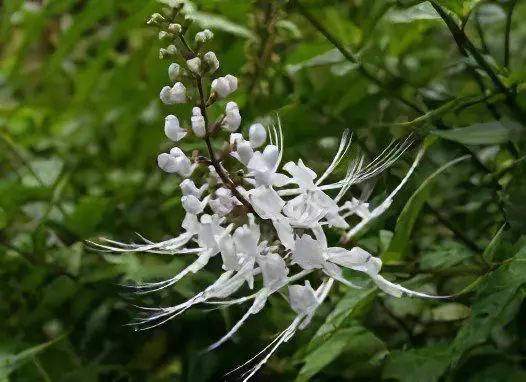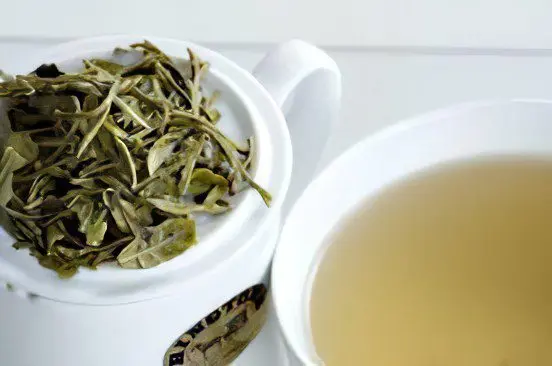Contents
Useful properties and application of orthosiphon stamens
Botanical characteristics of orthosiphon stamens

Orthosiphon staminate from the family of labiales, it belongs to evergreen shrubs, reaching a height of 0,8–1,2 meters. Its tetrahedral stems are greenish-purple in color and branch heavily. The leaves are oblong, opposite, short-petiolate, with serrated edges. Small pale purple flowers form racemes on the tops of the stems. Flowering time is July-August, but when grown in Russia, the plant practically does not produce seeds.
In its wild form, orthosiphon grows in the tropical rainforests of Sumatra, Java, Indonesia and northeast Australia. In Russia, it does not occur in nature, it is cultivated as an annual medicinal plant on the entire Black Sea coast, in the Crimea and the Caucasus.
Useful properties of orthosiphon
For medicinal purposes, the aerial part of the plant is used – leaves and flushes (apical shoots of leaves), which are collected 3-4 times during the entire growing season. The first time the apical and lateral shoots are collected at the end of July, before the orthosiphon begins to bloom. Then the harvesting of raw materials is carried out in August, September and October, when the tops and all green leaves are cut off. After drying, the moisture content of the finished raw material is usually no more than 10%.
The aerial part of the plant contains organic acids, tannins, fatty oil, bitter glycoside orthosiphonin, triterpene saponins. The leaves are also rich in potassium salts. As shown by pharmacological studies, the plant is not poisonous and has a mild diuretic effect without side effects.
The use of orthosiphon
The aerial part of the plant is used for kidney diseases, accompanied by swelling, uric acid diathesis, gout, arterial hypertension. Infusions and decoctions from orthosiphon have a beneficial effect on the patient’s body with cholecystitis, gastritis with low acidity, and liver diseases. It is recommended for infectious and inflammatory diseases of the urinary tract, as well as for the formation of sand or kidney stones.
Infusion: it is necessary to pour half a teaspoon of chopped dry grass with a glass of boiling water, bring to a boil and insist for 20 minutes. After filtering the product, it must be added with boiling water to the previous volume and drink 100 ml of warm infusion half an hour before meals 2 times a day. The infusion is prepared daily, the course of treatment is 1-1,5 months.
Decoction: 2-3 tablespoons of dry leaves are poured into an enamel bowl, poured with a glass of boiling water and heated in a steam bath for about 15 minutes. Infuse for 45 minutes, filter and bring the resulting volume to 200 ml by adding boiled water. The decoction is taken 2-3 times a day, 60-100 ml, half an hour before meals.
Orthosiphon leaves
During the last collection of raw materials in October, all green leaves are cut off from the plants, the length of which can reach up to 7 cm. They are dried and packed in packs of 50 g. The color of the dried leaves is brownish-green, the taste is bitter-astringent, the smell is barely perceptible. The quality of raw materials may be reduced due to the admixture of black leaves or stems longer than 50 mm and thicker than 2,5 mm. Store finished products usually in a cool and dry place.
Tea of orthosiphon
Orthosiphon stamens is an excellent diuretic used in the form of teas for diseases of the kidneys and urinary tract. The tea also has a slight antispastic effect.
Orthosiphon tea: it is prepared at the rate of 1 tablespoon of dry leaves per 500 ml of cold boiled water. Tea is infused for 8-12 hours, stirring occasionally. After straining, the drink can be slightly warmed up to a pleasant temperature for drinking. Dosage – 2-3 cups of tea during the day, drink a little in the evening.
A mixture of orthosiphon leaves and bearberry, used as a tea, is an excellent disinfectant and cleanser of the bladder and urinary tract.
Tea from a mixture of bearberry and orthosiphon: to make tea, 25 g of bearberry leaves and orthosiphon are preliminarily mixed, after which 2 teaspoons of the mixture are poured into 50 ml of cold boiled water, insisted for about 10-12 hours and filtered. Drink 2 cups of tea a day in a warm form.
Orthosiphon stamens – “kidney tea”

Kidney tea has found active use in many countries of the world; in Europe, it has been officially approved for use since 1950. Kidney tea improves the function of the tubules by increasing glomerular filtration, while taking it, alkalinization of urine occurs. It is effective for edema caused by heart failure, pyelonephritis, glomerulonephritis, cystitis, urethritis, kidney stones.
In patients with acute and chronic cholecystitis and cholelithiasis, with regular intake of kidney tea, pain sensations are significantly reduced, appetite appears, secretion of gastric juice increases, and the number of leukocytes and mucus in bile decreases.
Orthosiphon during pregnancy
Orthosiphon tea is the only diuretic that doctors safely prescribe during pregnancy. It is recommended both in the treatment of inflammatory diseases of the genitourinary system, and to eliminate edema that may occur in women in the second half of pregnancy. The taste of tea is quite tolerable, but it is not recommended to use it for more than three weeks in a row.
Recently, expectant mothers have increasingly begun to have questions about the possibility of drinking tea during pregnancy. This is due to the fact that some manufacturers began to indicate pregnancy among the contraindications on the packages. As doctors explain, today kidney tea is often called any kidney fees, which may include herbs, the intake of which is highly undesirable during pregnancy.
Real kidney tea, namely orthosiphon tea, does not pose a real threat to either the expectant mother or the fetus. On the contrary, it can significantly alleviate the unpleasant conditions of a pregnant woman.
Contraindications to the use of orthosiphon
There are no special contraindications for taking orthosiphon, although it is better to use decoctions and teas for dropsy against the background of heart or kidney failure only after consulting a doctor and under his supervision. Individual intolerance to the drug is also possible. Overdose should be avoided, as with any other medication.









